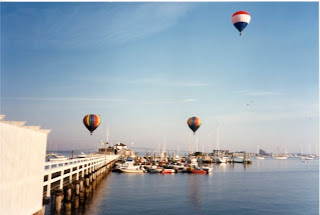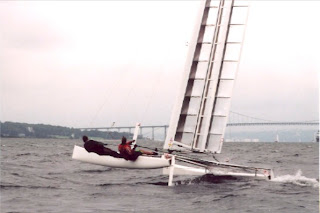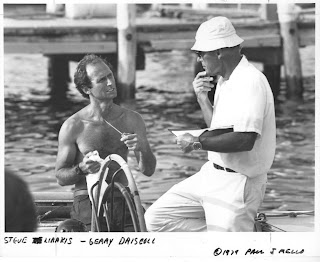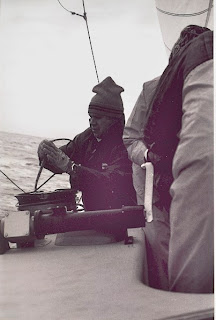 Teddy Nelson had been the Steward at Ida Lewis Yacht Club for many years. His father had held the position before him. Both had been devoted to the club.
Teddy Nelson had been the Steward at Ida Lewis Yacht Club for many years. His father had held the position before him. Both had been devoted to the club.

 Teddy Nelson had been the Steward at Ida Lewis Yacht Club for many years. His father had held the position before him. Both had been devoted to the club.
Teddy Nelson had been the Steward at Ida Lewis Yacht Club for many years. His father had held the position before him. Both had been devoted to the club.

Recently a posting on Ebay of the deck plan of Courageous reminded me of a past memory. Cowes Week 1975, We had been living in Cowes in an apartment over The Duke of York a pub at the top of the high street. Bob Miller aka Ben Lexen took over our lease. I left for the United States for the Trans-atlantic back to England. Leading up to that however, I spent time with Bob and Jack Knights, another great English sailor.
 Speedboat aka Virgin Money is an exciting boat,an engineering marvel, elegant, extreme, powerful, fragile. Not particularly useful as its purpose can only really be to set or break distance records. Yet she requires a great deal of attention.
Speedboat aka Virgin Money is an exciting boat,an engineering marvel, elegant, extreme, powerful, fragile. Not particularly useful as its purpose can only really be to set or break distance records. Yet she requires a great deal of attention.
 No three people have done more for the sport of sailing and speed than Dave Hubbard, Duncan MacLane, and Steve Clark. You probably don’t know who they are or what they have done.They just did it; and very well, genuinely interested in moving the sport of sailing forward. I am amazed that more is not made of their accomplishments.
No three people have done more for the sport of sailing and speed than Dave Hubbard, Duncan MacLane, and Steve Clark. You probably don’t know who they are or what they have done.They just did it; and very well, genuinely interested in moving the sport of sailing forward. I am amazed that more is not made of their accomplishments.


 The E scow is still my favorite monohull. I haven’t sailed one in years. They were still wood. Modern materials have made these boats even more dynamic. If the materials available today had been available 100 years ago the yacht designers and builders would have been on cloud 9. They had the ideas, the means of expression was limited.
The E scow is still my favorite monohull. I haven’t sailed one in years. They were still wood. Modern materials have made these boats even more dynamic. If the materials available today had been available 100 years ago the yacht designers and builders would have been on cloud 9. They had the ideas, the means of expression was limited.
 The entry about wire sheets reminded me of an incident while sailing on Intrepid in 1979. If you read far enough back in my blog there is an entry about my two seasons aboard Intrepid with Gerry Driscoll. It was an attempt by Gerry to come back in 1980 with Intrepid. It was contingent on finding financial backing. We were sailing against France 3 everyday, as Intrepid belonged to Baron Bic at the time.
The entry about wire sheets reminded me of an incident while sailing on Intrepid in 1979. If you read far enough back in my blog there is an entry about my two seasons aboard Intrepid with Gerry Driscoll. It was an attempt by Gerry to come back in 1980 with Intrepid. It was contingent on finding financial backing. We were sailing against France 3 everyday, as Intrepid belonged to Baron Bic at the time.
 Jack’s book:”Messing About in Boats” was published earlier this year. He was in Newport this weekend for a book signing in conjunction with the 12 Meter North American Championships, at the Seaman’s Church Institute. Lots of people turned out. I first met Jack in the 1960’s, he was working at Ratsey&Lapthorn sailmakers, as was Arthur Knapp. I raced against him on Long Island Sound.
Jack’s book:”Messing About in Boats” was published earlier this year. He was in Newport this weekend for a book signing in conjunction with the 12 Meter North American Championships, at the Seaman’s Church Institute. Lots of people turned out. I first met Jack in the 1960’s, he was working at Ratsey&Lapthorn sailmakers, as was Arthur Knapp. I raced against him on Long Island Sound.
 When I started sailing rope sheets and guys were normal. The rope was not very sophisticated, it stretched quite a lot. As the boats became more evolved wire sheets and guys became normal. It was 7×19 galvanized, because it was more flexible. It rusted quickly and broke down just as fast. Your hands were constantly torn by the meathooks.
When I started sailing rope sheets and guys were normal. The rope was not very sophisticated, it stretched quite a lot. As the boats became more evolved wire sheets and guys became normal. It was 7×19 galvanized, because it was more flexible. It rusted quickly and broke down just as fast. Your hands were constantly torn by the meathooks.